The Best Neurofeedback Devices for Home Use: A Modern Guide
Discover The Best Neurofeedback Devices for Home Use in 2025. Compare top-rated options, key features, and benefits to find the perfect device for...
Researching home neurofeedback devices is challenging. Their are many devices and the price range is wide. Learn more to find the best system for you.
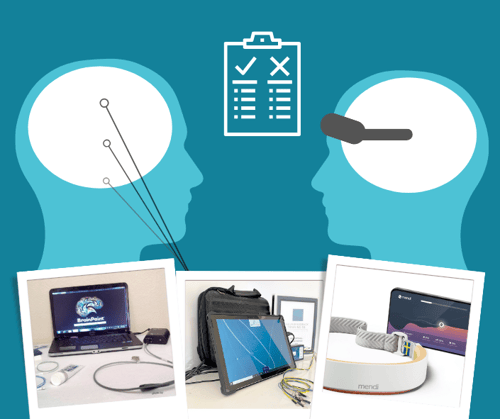 In 2023, the market for home neurofeedback systems has experienced an unprecedented boom thanks to the latest advancements in the industry. Over the past five years, a fresh wave of headbands and smartphone devices designed for direct-to-consumer use have been introduced. While this surge in options is a positive development, it also presents challenges. The lack of regulatory oversight for the term "neurofeedback" has resulted in a broad range of products with varying capabilities and purported benefits being marketed under that label. These systems run the gamut from professional EEG-based equipment adapted for home use to low-cost headbands that require minimal computing power, and prices can vary widely from a few hundred to tens of thousands of dollars. Given this maze of options, it can be difficult for consumers to sort through the information. This article aims to clarify the distinctions between different systems, the scientific principles behind them, and the expected outcomes.
In 2023, the market for home neurofeedback systems has experienced an unprecedented boom thanks to the latest advancements in the industry. Over the past five years, a fresh wave of headbands and smartphone devices designed for direct-to-consumer use have been introduced. While this surge in options is a positive development, it also presents challenges. The lack of regulatory oversight for the term "neurofeedback" has resulted in a broad range of products with varying capabilities and purported benefits being marketed under that label. These systems run the gamut from professional EEG-based equipment adapted for home use to low-cost headbands that require minimal computing power, and prices can vary widely from a few hundred to tens of thousands of dollars. Given this maze of options, it can be difficult for consumers to sort through the information. This article aims to clarify the distinctions between different systems, the scientific principles behind them, and the expected outcomes.
The market for home neurofeedback systems includes devices that were initially designed for professional use but have since been adapted for consumer use, or have a model for clinician-supervised home-use. In this article, we will examine three such devices: BrainPaint®, Mynerva®, and NeurOptimal®. The first two systems belong to the first generation of neurofeedback design known as protocol or linear neurofeedback. On the other hand, NeurOptimal® represents the latest generation of EEG neurotherapy, called Dynamical Neurofeedback.
)%201.jpg?width=500&height=419&name=article%20-%20best%20home%20neurofeedback%20systems%20options%20(Facebook%20Post%20(Landscape))%201.jpg) Protocol or linear neurofeedback requires a prior diagnosis or brain map (QEEG) before treatment can begin. Such diagnoses may include conditions such as anxiety, autism, or ADHD. If a brain map is performed, it provides a single, static image of the brain's electrical activity, indicating areas that may be over or underactive. Using this information, a clinician will establish protocols or parameters for brain wave activity that, over time, will steer the brain toward healthier patterns. Feedback is delivered through either auditory or visual cues, alerting the individual when their brainwaves fall outside the desired range and prompting automatic self-adjustment.
Protocol or linear neurofeedback requires a prior diagnosis or brain map (QEEG) before treatment can begin. Such diagnoses may include conditions such as anxiety, autism, or ADHD. If a brain map is performed, it provides a single, static image of the brain's electrical activity, indicating areas that may be over or underactive. Using this information, a clinician will establish protocols or parameters for brain wave activity that, over time, will steer the brain toward healthier patterns. Feedback is delivered through either auditory or visual cues, alerting the individual when their brainwaves fall outside the desired range and prompting automatic self-adjustment.
During a protocol neurofeedback session, EEG sensors are attached to the head and connected to a computer system. If visual feedback is employed, the patient may watch a movie, and the monitor's brightness will increase when desirable brain activity is detected, while it will decrease when maladaptive activity is detected. Through the process of operant conditioning, the brain is encouraged to match favorable standards by suppressing or augmenting targeted brain frequencies.
When adapting protocol neurofeedback for home use, the clinician remotely monitors the patient's progress and directs an adult in the home to administer the sessions, providing changes in the protocols based on feedback about changes in the patient's symptoms.
One of the advantages of using home protocol systems is the clinician's oversight, which can help to put patients at ease. The active involvement of the patient in the treatment process can also provide them with a sense of control. Furthermore, the in-depth readings of brain maps allow those who desire quantitative data to observe changes in brain frequencies over time, thereby validating their progress. However, setting protocols and measuring progress can be challenging, particularly when dealing with multiple symptoms. Additionally, there are reports of temporary side effects that may cause short-term discomfort but ultimately resolve themselves.
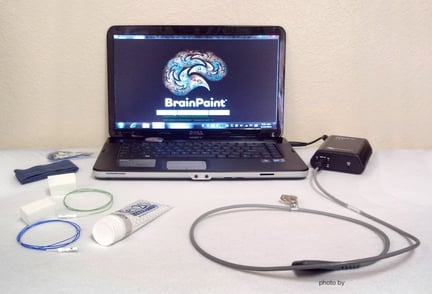 BrainPaint a protocol neurofeedback device that starts with an in-depth questionnaire that is then used to decide the protocols to use for training. During a BrainPaint session, a person's brainwave activity is measured using 1-3 sensors placed on the scalp. This data is fed into a computer, which analyzes the brainwave patterns and provides real-time feedback in the form of audio and visual stimuli. The sensors may be moved periodically during the session, which lasts 25-30 minutes.
BrainPaint a protocol neurofeedback device that starts with an in-depth questionnaire that is then used to decide the protocols to use for training. During a BrainPaint session, a person's brainwave activity is measured using 1-3 sensors placed on the scalp. This data is fed into a computer, which analyzes the brainwave patterns and provides real-time feedback in the form of audio and visual stimuli. The sensors may be moved periodically during the session, which lasts 25-30 minutes.
The audio and visual feedback is designed to help the person train their brain to produce more optimal brainwave patterns, such as reducing over- or under-active brainwaves in specific areas of the brain. Over time, this can help the brain learn to self-regulate and improve its overall functioning.
BrainPaint® is often used to address a range of mental health concerns, including anxiety, depression, attention-deficit/hyperactivity disorder (ADHD), post-traumatic stress disorder (PTSD), and sleep disorders. It is also used to enhance cognitive performance and to support peak performance in athletes and other high-performing individuals.
BrainPaint® is also available for home users who live more than fifty miles from a BrainPaint® provider.
Prices vary but typically cost It costs $675-1500 per month with a two-month minimum, and an additional fee per month fee for each additional user.
See this video from protocol-based system BrainPaint on how it works.
 MyNeurva is a protocol-based neurofeedback system that helps improve symptoms related to conditions such as depression, ADHD, and anxiety. Licensed mental health professionals provide guidance and support throughout the process. Training sessions are done remotely at home and progress is tracked online.
MyNeurva is a protocol-based neurofeedback system that helps improve symptoms related to conditions such as depression, ADHD, and anxiety. Licensed mental health professionals provide guidance and support throughout the process. Training sessions are done remotely at home and progress is tracked online.
Prior to beginning sessions, a home QEEG device is used to create a brain map. This is done using an electrocap and connecting it to an amplifier and computer provided by the company. This QEEG serves as a baseline to set protocols for brain training. Once this is done, the clinician evaluates the map and decides the software protocols that will be entered for the sessions.
The neurofeedback training sessions last around one hour with thirty minutes of eyes-open and thirty minutes of eyes-closed training. During these sessions, real-time feedback is provided based on personal treatment plans. The initial QEEG is then compared to follow-up QEEGs to observe how brain patterns have changed
MyNeurva's most popular package provides 20 neurofeedback sessions for $4,899.00.
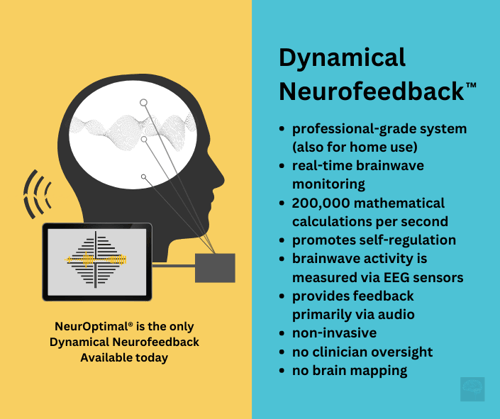
Dynamical neurofeedback represents the latest generation of professional-grade neurofeedback systems. Its implementation was only possible once computer speeds reached the level of the human brain, allowing it to use real-time brainwave monitoring rather than a static QEEG brain map to promote self-regulation and improve brain function.
What sets it apart from traditional neurofeedback systems is its foundation in the principles of dynamical systems theory, which views the brain as a complex, non-linear, self-organizing system that constantly adapts to changing internal and external environments. Rather than focusing solely on specific symptoms, the goal of training with dynamical neurofeedback is to teach the brain to function more efficiently and effectively throughout the day, beyond just the time spent using the device.
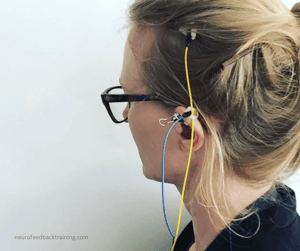 In Dynamical neurofeedback, a person's brainwave activity is measured using five sensors placed on the scalp, and clipped to the ears. The data is sent to an amplifier to amplify the brainwave data and then fed into a computer system. The computer does over 200,000 mathematical calculations per second analyzing the brainwave patterns looking for state change. At precise milliseconds it provides feedback designed to cue the brain to optimize its performance.
In Dynamical neurofeedback, a person's brainwave activity is measured using five sensors placed on the scalp, and clipped to the ears. The data is sent to an amplifier to amplify the brainwave data and then fed into a computer system. The computer does over 200,000 mathematical calculations per second analyzing the brainwave patterns looking for state change. At precise milliseconds it provides feedback designed to cue the brain to optimize its performance.
The Dynamical neurofeedback system utilizes real-time monitoring of maladaptive brainwave patterns during each session, providing simultaneous feedback on emotional and cognitive patterns. The primarily auditory feedback eliminates the need to focus on a screen, making it especially beneficial for children. The system's safety lies in the use of feedback solely to alter brain function, without forcing state changes. Furthermore, the fully automated system eliminates the need for manual protocol setting by an adult. While the system does not require clinician oversight, some individuals prefer systems that include qualitative brain mapping data, which can confirm changes but add to the cost.
 There is currently only one Dynamical system currently on the market: NeurOptimal®. Because of its Dynamical design the company created a home version to be used by consumers when it created the professional model. The systems are identical, though the home system does not have the backend data analysis needed for research studies. The system has a feature called AutoNav, which makes it fully automated. No protocols need to be set or changed.
There is currently only one Dynamical system currently on the market: NeurOptimal®. Because of its Dynamical design the company created a home version to be used by consumers when it created the professional model. The systems are identical, though the home system does not have the backend data analysis needed for research studies. The system has a feature called AutoNav, which makes it fully automated. No protocols need to be set or changed.
NeurOptimal® is used to support cognitive and emotional changes like other neurofeedback systems. Because the design is to capture all maladaptive brainwaves the changes can be seen across many areas of brain functioning from sleep to mood regulation and cognitive performance.
During a session, 5 EEG sensors are attached to the head and ears using conductive paste. Wet sensors, as they are called are used because they are the fasted means for transmitting electrical activity. The sessions are 33 minutes in length and the feedback is auditory. Music or the soundtrack of a video can be used to provide the feedback. Because there is not the need for conscious focus on a screen while training, individuals while can focus on activities such a reading or even fall asleep.
The cost for dynamical neurofeedback can range from $650-$950/month to rent depending on the number of sessions. This includes all the equipment required to train, paste for sensors, and guidance from certified trainers.
NeurOptimal® can also be purchased for home-use and their are two systems a Limited-Use System for $7495 or an Unlimited-Use system for $9995.
 Several home neurofeedback devices have emerged in the market over the past decade, designed for direct purchase by consumers. These devices are generally simpler in design and function, requiring less computer power and are therefore less expensive. Unlike professional-grade devices, these devices do not necessarily use EEG sensors to monitor brain activity, and if they do, they typically use dry EEG sensor technology in the form of a headband device. Although dry EEG sensors are effective, they are less precise than wet sensors and may be more susceptible to picking up environmental electrical "noise."
Several home neurofeedback devices have emerged in the market over the past decade, designed for direct purchase by consumers. These devices are generally simpler in design and function, requiring less computer power and are therefore less expensive. Unlike professional-grade devices, these devices do not necessarily use EEG sensors to monitor brain activity, and if they do, they typically use dry EEG sensor technology in the form of a headband device. Although dry EEG sensors are effective, they are less precise than wet sensors and may be more susceptible to picking up environmental electrical "noise."
Neurofeedback devices that are designed for direct consumer purchase are generally effective in inducing state changes during sessions, but are not intended to improve overall brain function. While these devices may improve focus and create positive changes during use, the effects are usually temporary and do not persist once the device is removed. However, these devices are much less expensive than professional systems, making them a cost-effective option for trying out neurofeedback technology.
It is crucial to review the scientific literature for each device since they use varying measurements and techniques to induce a state change. While all of these devices employ operant conditioning to modify behavior, the methods can significantly differ. Operant conditioning modifies behavior by using consequences, such as positive reinforcement or entrainment. For instance, giving a dog a treat when it sits is a form of positive reinforcement. An example of entrainment is the process where when different tempo metronomes are placed near each other gradually synchronize as they pick up on each other's movement. It is important to note that none of these systems trigger the natural process of dynamical learning but rather target specific pre-conceived change such as focus or relaxation.
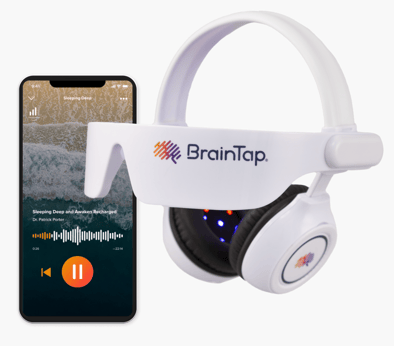 BrainTap is a device that provides pulses of light through earphones within the form of a headset. These lights operate in sync with two types of sounds, binaural beats and isochronic tones, in order to stimulate relaxation, focus, and other desirable brain states. This modality of working with the brain is a form of entrainment or migration. This involves synchronizing brain patterns with external stimuli.
BrainTap is a device that provides pulses of light through earphones within the form of a headset. These lights operate in sync with two types of sounds, binaural beats and isochronic tones, in order to stimulate relaxation, focus, and other desirable brain states. This modality of working with the brain is a form of entrainment or migration. This involves synchronizing brain patterns with external stimuli.
This is not an EEG device but a temporary shift in brain patterns, inducing state changes. BrainTap works by guided visualization audio-sessions and is compatible with a wide range of carriers such as smartphones or tablets. The user is guided through brainwave entrainment process designed for specific sessions and a subscription is $29.99/month.
.png?width=400&height=335&name=mendi%20home%20neurofeedback%20system%20(1).png) Mendi is a headband device that utilizes functional near-infrared spectroscopy (fNIRS) to detect changes in brain blood flow and oxygenation, rather than electroencephalography (EEG) or brainwaves. This system uses sensors to measure fNIRS signals which are then processed with proprietary algorithms to create visual feedback in the form of a game. Delivered through a mobile app, the user controls the movement of a ball. The more blood flow being detected in the prefrontal cortex, the steeper the upward curve. The key aspect of this technology is that it measures the brain's response to changes in activation, which allows for efficient and precise training.
Mendi is a headband device that utilizes functional near-infrared spectroscopy (fNIRS) to detect changes in brain blood flow and oxygenation, rather than electroencephalography (EEG) or brainwaves. This system uses sensors to measure fNIRS signals which are then processed with proprietary algorithms to create visual feedback in the form of a game. Delivered through a mobile app, the user controls the movement of a ball. The more blood flow being detected in the prefrontal cortex, the steeper the upward curve. The key aspect of this technology is that it measures the brain's response to changes in activation, which allows for efficient and precise training.
The Mendi headset can be purchased for $299.
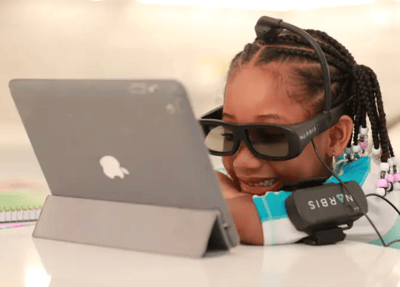 Narbis uses a NASA patented algorithm originally designed to track pilot's distractibility during flight. Used specifically to train attention related issues, this headset involves glasses with a tint that operates based on operant conditioning. When placed on, the glasses come with dry sensors that track brain activity. Specifically, activity associated with attention and relaxation states are measured such as alpha, beta, theta, and gamma frequencies. By analyzing this activity, Narbis determines when the user is unfocused.
Narbis uses a NASA patented algorithm originally designed to track pilot's distractibility during flight. Used specifically to train attention related issues, this headset involves glasses with a tint that operates based on operant conditioning. When placed on, the glasses come with dry sensors that track brain activity. Specifically, activity associated with attention and relaxation states are measured such as alpha, beta, theta, and gamma frequencies. By analyzing this activity, Narbis determines when the user is unfocused.
When distracted, a series of LED lights gently flash in the user's peripheral vision. These flashes coincide with the user's brainwaves, providing visual feedback that motivates the user to re-focus and pay attention. Over time, the user's brain is conditioned to associate flashes with the need to refocus, eventually reducing the need for continual use of the glasses. Designed to help users pay attention during everyday activities such as when doing homework, reading or working, Narbis essentially helps to train the "muscle" of attention.
The headset can be purchased for around $600.
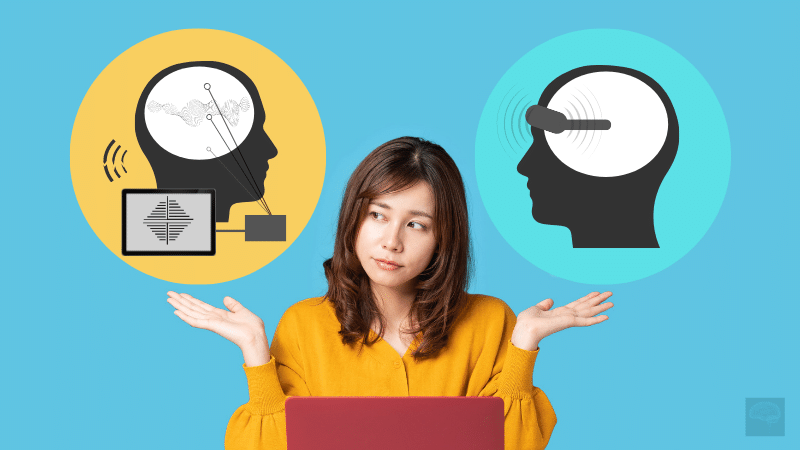
There are various home neurofeedback systems that fall into two broad categories: those that were designed for professional use, and those designed for consumer use. The former systems tend to be more sophisticated in design, require more computer technology and are more expensive. The latter consumer products tend to be for state-change, such as relaxation or focus, are simpler to use and often run on smartphones through an app. The cost is also more affordable. Before investing in any neurofeedback system, it is crucial to understand its scientific principles and functionalities. Given the brain's critical importance, such an investment deserves careful consideration.
Still have questions? Ask a certified neurofeedback trainer.
Natalie Baker has over 25 years of experience as a licensed psychotherapist and has been a NeurOptimal® neurofeedback trainer since 2011. She is the founder of Neurofeedback Training Co., which offers in-person sessions and runs the largest nationwide home rental program for NeurOptimal systems. Natalie also teaches meditation and Buddhist psychology and specializes in working with anxiety, stress, ADHD, and trauma.
Discover The Best Neurofeedback Devices for Home Use in 2025. Compare top-rated options, key features, and benefits to find the perfect device for...
How home neurofeedback works, explore the best neurofeedback device for home use, and learn if you can do neurofeedback at home safely with rentals...
New to neurofeedback? Learn beginner tips for safe, effective home brain training—including setup, pacing, tracking progress, and choosing the right...
Be the first to know about new blogs